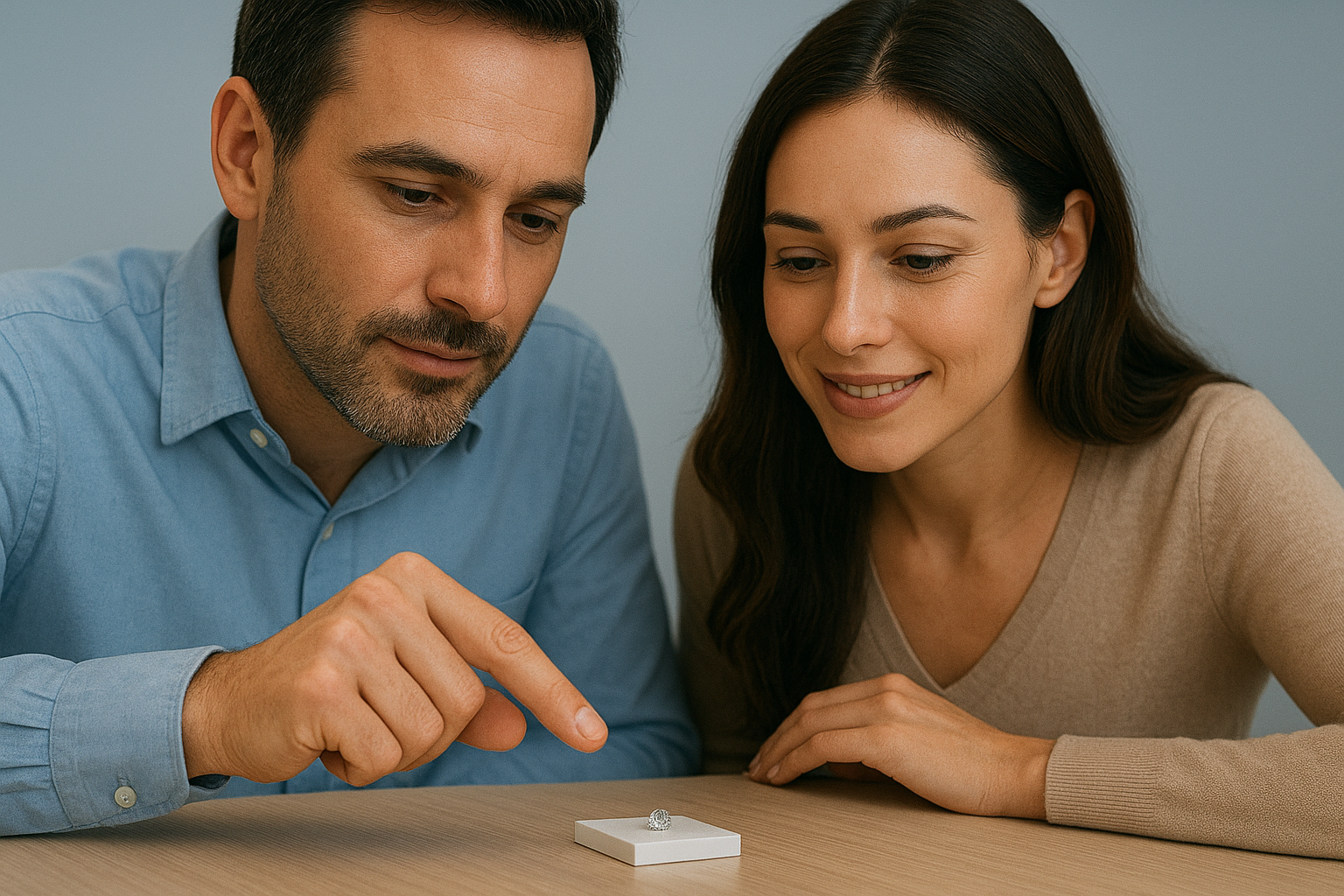Tips on Choosing Your Diamond & Evaluating How it Looks in Person.
Now comes the magic moment of looking for the perfect diamond for you engagement ring! We usually begin by looking at our excellent selection of diamonds on our supplier website, where we can see up to 80% of the world’s diamond inventory.
Viewing our selection of diamonds online is amazing! The the enlarged, high-resolution videos enable you to see the shape, the facet pattern and clarity details very easily. Then when you see the diamond you like in person, you’ll love it even more, when you see the brilliance and the way the light interacts with the diamond.
You see the sparkle with your own eyes, compare stones side by side, and see how a diamond looks on your hand. We help our clients that every week in our Greenville studio.
Here is the step-by-step process we use during appointments, so you can shop with confidence and enjoy the experience!
Step 1: Consider your priorities and budget
A clear plan helps you make good decisions when the right stone appears. Consider what matters most to you:
- A particular shape you have always loved
- Size on the finger, including the length and width (for shapes other than round)
- Fire and brilliance
- A classic white look color or a slightly warm tone (to allow you to choose a larger diamond)
- Eye-clean clarity with no flaws that are visible without magnification, or a higher clarity grade
When we discuss your goals, we tailor the selection to match your taste and budget. Our goal is to help you get the most beautiful diamond we can within your budget.
A quick tip: you can estimate the amount you can spend on the center stone if you deduct the cost for the setting you want. The setting protects the stone, suits your lifestyle, and makes a big difference in how the ring looks.
Step 2: Choose a shape that fits your style and hand
Shape guides the personality of the ring. Try a few on. Photos rarely capture how shape changes the look on your finger.
- Round: unmatched sparkle, classic, easy to pair with many settings
- Oval: elegant spread, often looks larger for the weight, check for bow-tie
- Cushion: soft edges, vintage or modern based on the cut style
- Emerald: hall-of-mirrors look, clarity matters more since the step facets act like windows
- Radiant: brilliant facets with a rectangular outline
- Pear: elongating and graceful, watch for even brightness tip to base
- Marquise: strong finger coverage, centered bow-tie can be distracting if too dark
- Princess: square outline with tons of sparkle, protect the corners
Shapes other than round have a length and width that you see from the top view. Some are more elongated than others, so we refer to the elongation as the length-to-width ratio.
Length to width ratios will vary between diamonds of the same carat weight. Many clients like ovals with a length-to width ratio around 1.35 to 1.50, pears around 1.50 to 1.60, emerald cuts around 1.30 to 1.45, and marquise around 1.90 to 2.20. More or less elongated diamonds can also be very beautiful. Try a few ratios in person to see what you like your best, both in the photos and on your hand.
Step 3: Use the Four Cs the right way in person
Cut, color, clarity, and carat are tools, not rules. Seeing diamonds with your own eyes lets you trade between them in smart ways.
- Cut: affects sparkle and contrast. A stone with excellent light return will look lively in many lighting conditions.
- Color: affects the tone you see, from icy white to soft warmth. Your metal choice matters here.
- Clarity: ranges from flawless to included. Many SI stones are eye-clean and offer strong value.
- Carat: relates to weight. Face-up size depends on measurements and cut, not just the number on the report.
We use side-by-side comparisons in neutral lighting so you can trust what you see.
Step 4: Inspect cut and light performance in real lighting
Good cut is the secret to that dance of light that makes people smile when they look at their hand.
Here is how we check it together:
- Neutral daylight or a daylight-balanced lamp for brightness.
- Diffused office light for evenness and contrast.
- Spot lighting for fire and flashes.
- Low light to see whether the stone still glows or goes dark.
We also use tools at the bench:
- a 10X or 40X jewelers loupe for magnification of the diamond
- A clean white tray to eliminate visual distractions
- Tweezers to hold the diamond and see it from every angle
- Simulated ring holders to help visualize the diamond on your hand
- Hearts & Arrows viewer on round “Hearts & Arrows” diamonds to check optical symmetry
- A diamond inscription microscope to read the laser inscribed lab certificate number
It’s important to understand that diamonds look very different in different lighting conditions. For example, outdoors on a cloudy day, or in an office with diffused lighting, the diamond will have less “sparkle”, but you will be able to see the facet pattern more clearly. Under bright spot lights, the diamond will sparkle brightly, but it will be more difficult to see the facet pattern.
Be sure you see the diamond in a variety of lighting conditions. The “diamond lights” in a retail store can make an inferior diamond look very good.
If a stone looks crisp and lively in several environments, you can count on it in daily wear.
Step 5: Evaluate clarity with your eyes first, then a loupe
Start at normal viewing distance, about 10 to 12 inches, then move closer. If you cannot see any inclusions without a loupe, you are in a great spot for value. After that, we look together under 10x.
What we look for:
- Black crystals or dark inclusions under the table are more visible than white wisps near the edge
- Feathers at the edge can be fine, but avoid ones that reach a corner on shapes with points
- Clouds that give a hazy or milky look are less desirable than a single pinprick
- Knots, cavities, or extra facets are not always a problem, but we explain what they mean for durability
Ask us to mark inclusions on the plotting diagram while you hold the stone. Seeing the map match the diamond builds trust in what you are buying.
Step 6: Compare color side by side on the hand
Color grading happens face down in controlled light, which is useful for consistency. Your eye sees face up, on your skin, in your metal color. That is what matters.
Try this in the studio:
- Place two stones on a white card, face up, then slide them onto your finger
- View in white gold or platinum tweezers, then in yellow or rose gold tweezers
- Check in daylight by the window and under LED spots
Here is a practical quick guide to how color reads with different metals.
| Color Grade Range | Common Name | On White Gold/Platinum | On Yellow/Rose Gold | Notes |
|---|---|---|---|---|
| D to F | Colorless | Icy white | Looks white, metal warms the look | Great if you love a bright white look |
| G to H | Near colorless | Face up white for most people | Blends beautifully with warm metals | Strong value zone for many clients |
| I to J | Slight warm tint | Slight warmth at the edge in white metal | Looks whiter in yellow or rose settings | Consider for vintage styles |
| K to L | Warm | Noticeably warm in white metal | Intentionally warm and charming | Pair with antique cuts or yellow gold |
Many clients land on G to I for white metals and H to K for yellow or rose, depending on taste.
Step 7: Look at measurements, not just carat weight
Two diamonds with the same carat weight can look very different on the hand. Depth and table size change the profile.
For rounds, use this as a quick reference:
- Around 1.00 ct: about 6.4 to 6.5 mm
- Around 1.50 ct: about 7.3 to 7.4 mm
- Around 2.00 ct: about 8.1 mm
Ask to see the millimeter measurements on the report and compare the spread across candidates. A slightly lighter stone with a better cut can look larger than a deeper, heavier one.
Step 8: Check fluorescence the right way
Fluorescence is a glow under ultraviolet light. It can help lower-color stones look a touch whiter in some environments. Strong or very strong fluorescence can create a hazy look in rare cases.
We:
- View the diamond under a UV lamp
- Look for any milkiness in normal lighting
- Compare with a non-fluorescent stone of the same color
If it looks crisp, fluorescence can be a friend that saves budget without sacrificing beauty.
Step 9: Review grading reports and what they mean
A grading report confirms quality details. It is not a replacement for your eyes, but it supports what you see.
Here is a quick guide to common labs.
| Lab | What to Know | Our Take |
|---|---|---|
| GIA | Widely trusted across the trade, consistent color and clarity grading, full cut grade for rounds | A reliable baseline for comparison |
| AGS (now part of GIA) | Known for light performance grading, many reports now issued by GIA | Excellent light performance data on legacy reports |
| IGI | Common in many markets, useful for modern lab-grown diamonds as well | We verify in person and match to your taste |
We go through the report together so the numbers match what you see in the tray.
Step 10: Pair the diamond with the right setting
A good setting protects the stone and completes the look. Bring lifestyle into the conversation.
- Active hands or a hands-on job: consider a bezel or low-profile setting
- Love sparkle: pavé on the band or a refined halo
- Want extra presence: a refined halo can make a 1.25 ct appear closer to 1.50 ct on the hand
- Clean lines: a solitaire with tapered shoulders or a cathedral band
- Metal: platinum for strength and a bright white, 14k or 18k for color options and different feels
We keep a range of styles in the studio for try-ons. Two client favorites from our collection are the KI-115024-W for a refined, modern look and the Cherie KI-115182-W for a romantic, delicate profile. We also build fully custom designs from the ground up, from an emerald cut cathedral to an Art Deco inspired remount using family diamonds.
Step 11: Weigh value across the whole ring
It is smart to shift budget to the details that matter most to your eye.
Ideas that work well:
- Choose eye-clean SI clarity and put savings into a higher cut grade
- Select G to H color in white metals or H to J in yellow and rose to stretch size without losing a white look
- Pick a setting that amplifies presence, like a thin pavé band or a halo, rather than paying a big premium to jump one more carat tier
We help you compare options on your hand, not on paper.
What a Sabyl’s appointment in Greenville looks like
Appointments are one on one with a designer. We start by learning your priorities, then curate a tray that fits your budget and taste. Expect education without pressure and side-by-side comparisons you can trust.
What sets our process apart:
- Access to about 80% of the global diamond market and millions of diamonds and gemstones
- Thousands of settings, including made-to-order and ready-to-ship styles
- Full custom design with no upfront payment
- Pricing often up to 30% below traditional retail
- Local, by-appointment service with the transparency of online pricing
- Most diamonds or settings sourced in a day when needed
- A make-it-right promise so the final ring matches what you pictured
We build engagement rings, wedding bands, and gifts across every milestone. From classic diamond studs to an Add-a-Diamond bracelet or a 3 ct pavé bracelet, we stand behind the same quality and personal care.
A step-by-step walkthrough you can use in the studio
Use this checklist during your visit. It keeps the process calm and clear.
- Try three shapes you like on your hand
- Narrow to two shape and ratio choices
- Compare three to five diamonds side by side in neutral light
- Eliminate any with visible inclusions at normal viewing distance
- Check light performance with ASET or an IdealScope
- Compare color on your hand in two metal tones
- Review measurements and face-up spread
- Look at fluorescence under a UV lamp, then verify no haze in normal light
- Confirm the grading report aligns with what you see
- Place your favorite stone in two settings, then decide
Bring a phone photo of your partner’s hand or a ring they wear for scale. If this is a surprise, we can help with sizing strategies and discreet timing.
Common myths we hear in the studio
We like busting myths so you can focus on what really matters.
- You need D color or it will look yellow
- Many G and H diamonds look perfectly white face up in white metal. Try them side by side.
- VVS clarity is required for sparkle
- Sparkle comes from cut. An eye-clean SI diamond can look every bit as lively as a VVS.
- Carat weight equals size
- Spread in millimeters and cut quality determine how big a stone looks on the hand.
- Fluorescence is always bad
- It can be helpful in many cases and is only a concern if it causes haze, which we check during your visit.
- Hearts and arrows is all that matters for rounds
- Optical precision is great, but we also care about overall light return and how the stone behaves in many lighting conditions.
Sample proportions we like to see on a round brilliant
Numbers do not tell the whole story, but they help filter. As a starting point, we often like these ranges for modern rounds:
- Table around 54 to 58 percent
- Total depth around 60 to 62.5 percent
- Crown angle around 34 to 35 degrees
- Pavilion angle around 40.6 to 40.9 degrees
We still verify with light performance tools and your eyes. A diamond that sings in real life is the goal.
Vintage and fancy shapes need different checks
Fancy shapes and antique cuts are beautiful, and they each have quirks worth checking in person.
- Ovals, pears, and marquise: look for a soft, even gradient across the center to limit a distracting bow-tie
- Emerald and Asscher cuts: clarity and symmetry matter more than tiny differences in color, so focus your budget accordingly
- Cushions: determine if you prefer chunky facets or a crushed-ice look, then compare within that family
- Old European or old mine cuts: accept a touch more warmth and prioritize personality and pattern
We keep ASET tools for fancy shapes too, and we will show you how each facet pattern behaves.
Try-on tips to get a real feel
A few small tweaks during the try-on can change your perception in helpful ways.
- Wash hands to remove lotion that dulls sparkle
- Sit and stand to see the ring at different angles
- Step to the window for natural light
- If choosing a halo, try two halo sizes to calibrate presence
- Take a short video on your own phone for later review
We are happy to send you home with side-by-side photos or videos so you can think clearly without pressure.
Ready when you are
If you are in Greenville, schedule a time to sit with us in the studio. We will pull a tailored selection that fits your budget, whether that is a classic round solitaire, a custom emerald cut cathedral, with a hand-picked oval. If we do not have the exact stone in the case, we tap into our wider network and usually have it here the next day.
We look forward to helping you choose a diamond in person, with clear guidance and a calm, friendly process that makes the ring feel like it was always meant to be yours.


